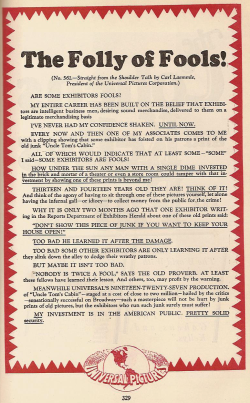Vintage: The Folly of Fools
We're going to start a new series of posts here that will run every Thursday, wherein we will feature some vintage materials from bygone eras of filmmaking. The world of film, and indeed the world at large, has changed dramatically over the last century. We can learn about the differences, but often a dry history lesson doesn't hit home and inspire the imagination as well as actually seeing the products of the times.
At some future date, we may certainly wind up jumping around in time a bit, but for the indefinite future, this vintage series will focus on the years 1927-1929, and the materials will all come from The Film Daily Yearbook, the 1928 and 1929 editions, which was the IMDb of its day, an exhaustive almanac for the movie industry, loaded with lists, editorials, ads, facts, and figures. We'll focus not so much on specific movies, most of which are lost to time anyway, but on the way the industry worked, the way movies were seen, legal issues and social perceptions that may seem odd to us today. We'll look at old technologies, advertising, press materials, news headlines, and predictive (and often wrong) editorials of the first movie moguls. All with an eye to relating everything to the current day.
Because sometimes we forget just how different things were 80 years ago. The fact that we can sit down and watch a movie from that time on modern equipment makes the past seem a lot less remote than it probably is. But it was a different world. Of course, the biggest movie-related transition that took place in 1927-1929 was the advent of talkies, and that subject will crop up again and again.
I'll try to zero in on human interest items wherever possible and try to keep from sounding like Ben Stein teaching history. The materials I'll be presenting absolutely fascinate me and kindle my imagination of what must have been like to see the movies being born. My hope is that I can convey that in this series.
Next week, I'll post some general information that sets the tone for the time period we'll be talking about, but this week I thought we'd plunge right in and feature just a single ad that says a lot about how differently people looked at movies 80 years ago.

This image is an ad for the then-new, now-classic 1927 version of Uncle Tom's Cabin. Until the end, though, the ad takes the form of a public service announcement for theater owners, suggesting that they should cease screenings of the 1914 version, because, hey, the 1914 version is 13 years old and probably looking pretty shabby. The solution? Throw it out and air the new 1927 version instead.
Today, remakes are generally assumed inferior until proven otherwise. This includes literary adaptations, like Uncle Tom's Cabin, where the original isn't the original anyway. But in 1927, films were seen more like theater. A local theater company puts on a version of something, it runs its natural course, and everybody moves on. The latest production of The Pirates of Penzance at your local community theater is the one that matters. The one five years ago might have been great, but it's over, and everybody has moved on.
The semi-permanence of film allowed theater owners to hold onto "old" productions and screen them for as long as the film would physically hold together, but it doesn't mean the exhibitors weren't seen as cheap for doing so. Why show old "junk" if there's a perfectly good, new, hip, modern version you can buy instead?
The cynic in me wants to say that casual moviegoers still feel this way. I cringe whenever I hear someone call a 13 year old movie (for example, Groundhog Day) "old." But the reality is that even at our most casual, we're more of a mind to want to preserve what we've got. Videos, DVDs, and television have seen to that. We are armed with ways to keep our favorite movies about us, and so we expect to be able to do that. And I don't personally know anybody (thankfully) that subscribes to the general attitude that once a remake comes out, there's no further use for any prior version. If anything, the usefulness of the remake is what's doubted. Of course, the above scan is advertising copy, not an editorial, and must be taken accordingly. Still, it's reflective of the times.
Then, of course, there is the nature of the ad itself, which amuses me to no end. Can you imagine an ad like this being printed today? Basically, you're an idiot if you don't do what this ad says. I particularly love how it goes to great pains to allow for exceptions -- that you, as an exhibitor, might not be a complete dunderhead -- seemingly because the advertiser knows full well he's on the brink of causing offense. But in fact if you are the target audience of this ad, the exception doesn't actually apply to you, so it's still insulting.
Admittedly, in the entire 1000 page volume of The Film Daily Yearbook 1928, rife with ads, this was the only one that took such an adversarial tack. Nonetheless, I can't imagine any such ad at all today. Today, people would be likely to boycott the 1927 version and keep the 1914 just to stick it to the jerk in marketing. We're accustomed to our ads coddling us, and by golly they'd better.
|


